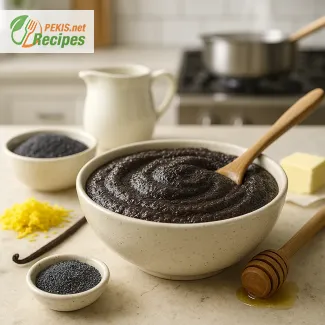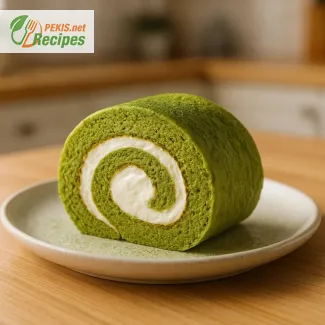
Elegant Layers of Flavor: Exploring the Pistachio Entremet
A refined dessert with French inspiration and pistachio excellence
The Pistachio Layered Entremet is more than a dessert—it's a refined composition of textures, flavors, and visual artistry rooted in classic French pâtisserie. Crafted to impress both the eye and palate, this multi-layered mousse cake features pistachio as the star ingredient, weaving through airy mousses, delicate sponges, and silky inserts to deliver an unforgettable dessert experience. Each layer plays a crucial role in creating a dessert that balances richness with elegance, offering both structural sophistication and intense flavor.
At the heart of this entremet is a velvety pistachio mousse, known for its light, melt-in-your-mouth texture that elevates the natural sweetness and nuttiness of pistachios. This core element is often paired with a moist pistachio sponge or joconde, which adds a gentle bite and reinforces the main flavor profile. To contrast the nutty base, many versions include an insert of raspberry or cherry gelée, introducing a vibrant tartness and an elegant color contrast within the sliced cake. These elements are brought together with a mirror glaze or velvet spray finish, giving the dessert its signature polished look.
What sets a pistachio entremet apart from other mousse cakes is its intricate architecture. The construction typically includes four to six distinct layers: biscuit, crunch base, mousse, fruit insert, glaze, and sometimes a glaze decor. Every component must complement the others in both flavor balance and texture hierarchy. While the mousse provides softness and airiness, the base adds crunch or chew, and the glaze seals everything in with a visually stunning finish.
In high-end patisserie, entremets are considered a form of edible art. Their structure demands precision, timing, and professional technique—from proper emulsification of the mousse to exact chilling phases for layering. The pistachio variant appeals especially to those seeking a dessert that is both nutty and delicate, offering a slightly savory depth that cuts through the sweetness. The popularity of pistachio as a premium ingredient has soared in recent years, thanks to its association with gourmet creations and Mediterranean flavor traditions.
The choice of ingredients and layering in a pistachio entremet reflects a balance of richness and finesse. High-quality pistachio paste—preferably 100% pistachios without added sugar or colorants—is crucial for achieving the natural green tone and aromatic intensity. Additional layers such as a white chocolate crunch or feuilletine base introduce textural interest, creating contrast with the smooth mousse. Carefully calibrated sweetness ensures the dessert remains light and not overpowering, making it ideal for special occasions such as birthdays, weddings, or festive dinners.
With the rise of modern pastry techniques, the pistachio entremet has become a favorite among pastry chefs for showcasing skill and creativity. Its clean cuts, glossy finishes, and vibrant cross-sections make it ideal for visual presentation, while the interplay of components delivers a complex flavor journey in every bite. Whether made in a silicone mold or finished with intricate decorations, this entremet stands as a benchmark of contemporary dessert craftsmanship.
In the world of layered cakes, this pistachio mousse cake occupies a unique space—one that combines precision, elegance, and gourmet flavor. It is not just a dessert but a culinary statement, reflecting a harmony of French patisserie expertise and the rich, nuanced profile of pistachios. Perfectly chilled and sliced with precision, the entremet reveals its internal story: layer after layer of textures and colors that excite the senses and celebrate the beauty of multi-layered mousse creations.
1. Prepare the pistachio joconde sponge:
Whisk together eggs, egg yolks, icing sugar, almond flour, and pistachio paste until light and airy. Sift in the flour. Separately, beat egg whites with granulated sugar to soft peaks and fold gently into the batter. Fold in melted butter last. Spread on a lined baking tray and bake at 200°C (390°F) for 8–10 minutes. Let cool and cut into two 16 cm (6.3 inch) circles.
2. Make the raspberry gelée insert:
In a saucepan, heat raspberries with sugar and lemon juice until bubbling. Blend smooth, strain if desired. Soak gelatin sheets in cold water, then melt into the warm puree. Pour into a 14 cm (5.5 inch) ring and freeze until solid.
3. Make the white chocolate crunch base:
Melt white chocolate and stir in pistachio paste and feuilletine flakes. Spread into a 16 cm ring on parchment paper and chill until firm.
4. Prepare pistachio mousse:
Soak gelatin in cold water. Whisk egg yolks with sugar. Heat milk in a saucepan and slowly pour over yolk mixture while whisking. Return to low heat and stir until thickened (83°C / 181°F). Melt in pistachio paste and gelatin. Let cool to room temperature. Fold in whipped cream gently.
5. Assemble the entremet:
In a 16 cm (6.3 inch) mousse ring with acetate, place the crunch base. Pipe in a layer of pistachio mousse. Add a sponge disc. Add more mousse, then the frozen raspberry insert. Add more mousse and the second sponge disc. Top with final mousse layer, smooth the top, and freeze overnight.
6. Make the mirror glaze:
Soak gelatin in cold water. Heat glucose, condensed milk, and water in a saucepan until simmering. Pour over chopped white chocolate, add gelatin, and emulsify with immersion blender. Add coloring. Let cool to 32°C (90°F).
7. Glaze the entremet:
Unmold frozen entremet. Place on wire rack over tray. Pour glaze evenly over the top. Let excess drip. Transfer to serving plate and refrigerate for 2–3 hours before serving.
Crafting a Refined Pistachio Dessert at Home
Techniques and variations to elevate your pistachio entremet
Creating a Pistachio Layered Entremet at home opens a world of possibilities to personalize, refine, and even improve upon the traditional version seen in pastry boutiques. While the base recipe offers a balanced and elegant dessert, small ingredient upgrades, technique improvements, and creative additions can make a noticeable difference in both flavor and texture.
Choose high-quality pistachio products
One of the most critical decisions lies in selecting the right pistachio paste. Many commercially available versions are diluted with sugar, oil, or food coloring, which weakens the natural aroma and depth. Opting for 100% pure pistachio paste delivers a significantly richer nutty flavor, a more natural green hue, and better consistency in the mousse. You can also make your own pistachio paste by blending lightly roasted pistachios with a touch of neutral oil, which adds a fresh and clean taste to the dessert.
Enhance complexity with secondary flavors
While pistachio is the central flavor, complementary elements can transform the profile of the entremet. A subtle layer of dark chocolate ganache between the mousse and sponge adds contrast and depth, cutting through the sweetness and enhancing the overall balance. For a fruity twist, try using apricot, cherry, or passionfruit instead of raspberry in the gelée insert. Each fruit brings a different acidity and aroma that influences the sensory journey of each bite.
Adding a pinch of sea salt to the mousse or sponge is another advanced technique to amplify the pistachio flavor. This small touch helps highlight the nutty base and rounds off the sweetness, creating a more sophisticated dessert profile.
Upgrade texture through layering techniques
The structure of an entremet relies on a careful balance between soft, creamy, and crunchy textures. Replacing the traditional feuilletine base with a mix of toasted pistachios and crisped rice provides more bite and a rustic touch. For added elegance, consider incorporating a thin dacquoise layer—a baked meringue with ground nuts—for an airy, nutty crunch that complements the sponge.
To ensure the mousse sets properly and cuts cleanly, use a digital thermometer when preparing the crème anglaise base. Heating it to the optimal 83°C (181°F) before incorporating the gelatin ensures both safety and proper texture. Letting it cool slightly before folding in the whipped cream helps maintain volume and smoothness.
Avoid common mistakes
Over-whipping the cream for the mousse is a frequent pitfall. It should reach soft peaks—firm enough to hold shape but still pliable—so that it incorporates evenly without breaking the emulsion. Another common issue is pouring the mirror glaze when it’s too warm, which can melt the outer mousse layer and ruin the finish. Always wait until it cools to 32–34°C (90–93°F) for a flawless coat.
Incorrect freezing is another hazard. The entremet must be completely frozen before glazing to avoid uneven surfaces or internal collapse. Allow sufficient chilling time—typically 8 to 12 hours—before proceeding with the final decor.
Healthier adaptations without sacrificing quality
To lighten the recipe while maintaining integrity, a few adjustments can be made. Greek yogurt can replace part of the whipped cream in the mousse to lower the fat content while adding a slight tang. Using stevia or erythritol instead of granulated sugar in the sponge and gelée can reduce overall sugar without heavily impacting structure, though the sweetness profile will differ.
Consider using whole grain flour or spelt flour in the sponge layer to increase fiber and add a subtle earthiness that complements pistachios. However, these flours absorb more liquid, so adjusting the batter consistency may be necessary.
For a dairy-free version, substitute plant-based cream alternatives (such as soy or oat) and use vegan white chocolate in the glaze. Keep in mind that these ingredients often behave differently in emulsions and aeration, so additional stabilizers like agar or pectin might be needed.
Why homemade is better
Preparing a pistachio entremet from scratch ensures full control over ingredient quality, sweetness levels, and texture precision. Homemade versions allow bakers to avoid additives and artificial coloring often found in store-bought options. Additionally, adjusting flavor intensity to suit personal preferences—more pistachio, less sugar, or deeper fruit notes—can make the final dessert both healthier and more satisfying.
The ability to customize also allows for seasonal adaptations. In warmer months, citrus elements like yuzu or lime zest can brighten the profile, while in colder seasons, touches of cardamom or cinnamon bring warmth and complexity.
Every layer of a pistachio entremet contributes to its harmony. By making thoughtful adjustments and learning how ingredients interact, bakers can push the boundaries of the traditional recipe to create a uniquely personal and elevated version. Whether you're refining the mousse, enriching the base, or enhancing the fruit insert, each choice influences the dessert's identity—making the journey of crafting it at home both creative and rewarding.
Allergens present in the recipe:
- Eggs
- Milk / Dairy
- Nuts (Pistachio, Almond)
- Gluten (Wheat Flour)
Gluten-free and allergen substitution tips:
- Replace cake flour with a certified gluten-free flour blend.
- Use dairy-free white chocolate and plant-based whipping cream for a lactose-free version.
- Replace almond flour with sunflower seed flour for nut allergies.
- Use egg replacer for sponge and mousse (though results may vary).
Vitamins and minerals per serving (approximate):
- Vitamin E: 2.5 mg – supports immune function and antioxidant protection
- Vitamin B2 (Riboflavin): 0.2 mg – aids energy metabolism
- Calcium: 70 mg – essential for bones and muscle function
- Iron: 1.6 mg – supports red blood cell formation
- Magnesium: 35 mg – supports nerve and muscle function
- Potassium: 210 mg – helps regulate blood pressure
- Phosphorus: 110 mg – important for bone structure and cell energy
Antioxidants per serving (approximate):
- Pistachio polyphenols: ~200 mg – anti-inflammatory, heart protective
- Raspberry anthocyanins: ~150 mg – contribute to antioxidant capacity and cell repair
- Vitamin C (from lemon and raspberry): ~6 mg – immune boosting and skin health
- Lutein + zeaxanthin: ~1 mg – protect eye health and reduce oxidative stress





